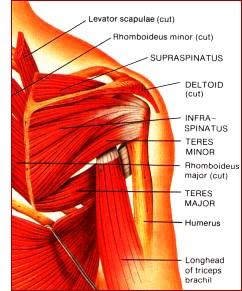
The scapula plays several roles in facilitating optimal shoulder function when scapula anatomy and biomechanics interact to produce efficient movement.
When weakness or dysfunction is present in the scapular muscles, normal scapula positioning and mechanics may become altered. When the scapula fails to perform its stabilization role, shoulder function is inefficient, which can result not only in decreased neuromuscular performance but also may expose the individual to shoulder injury.
Common to fast bowlers in cricket is an overuse injury. This is due to the repetitive over-head activity that the shoulder joint (glenohumeral joint) performs during a bowler’s action.
During all movements of the glenohumeral joint (especially movements involving more than 90° of flexion or abduction), it is important that the scapula-stabilizing muscles be strong enough to properly position the scapula.

Thus, the role of the scapula in upper extremity function must be considered in any shoulder trainin program.
While maintaining dynamic stability, the scapula muscles must at the same time provide controlled mobility. The scapula must also rotate upward with overhead activities to clear the acromion from the rotator cuff. Upward rotation and elevation are required in order to tilt the acromion upward, hence decreasing the likelihood of impingement and coracohumeral arch compression.

The second role the scapula plays is as a base for muscle attachment. The muscles that stabilize the scapula attach to the medial border of the scapula, thereby controlling its position. In addition to acting as scapula stabilizers, muscles that attach along the lateral border of the scapula perform gross motor activities of the glenohumeral joint.
The third role of the scapula is best represented as the link in the proximal-to-distal transfer of energy that allows for the most appropriate shoulder positioning for optimal function. These actions can be accomplished most effectively through the stable and controlled platform of the scapula, so that the entire arm rotates as a unit around the stable base provided by the scapulothoracic and the glenohumeral joints.
Most of the abnormal biomechanics and overuse injuries that occur about the shoulder girdle can be traced to alterations in the function of the scapula-stabilizing muscles.

The evaluation of scapula function is critical to overall success in managing injuries of the shoulder girdle and upper extremity. Several different methods evaluate scapula function. The first step in the evaluation process is to observe the scapula, both statically and dynamically, in relation to its role in the entire kinetic chain.
The shoulder must be considered a kinetic chain made up of several joints. The normal function of the scapula and surrounding muscles is vital to the overall normal function of the shoulder. An effective exercise regime for rehabilitation, as covered in an earlier blog, should include improving the strength and function of the muscles that control the position of the scapula. Weakness of these anchoring muscles may lead to altered biomechanics of the glenohumeral joint, with resultant excessive stress imparted to the rotator cuff and anterior capsule.

Source
VOIGHT, M.L. (2000) The Role of the Scapula in the Rehabilitation of Shoulder Injuries
Journal of Athletic Training, 35(3): 364–372
No comments:
Post a Comment